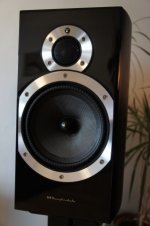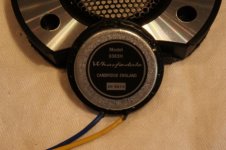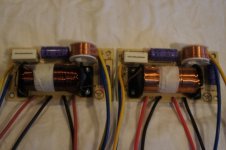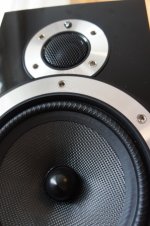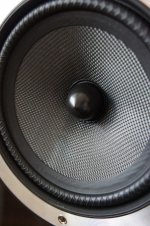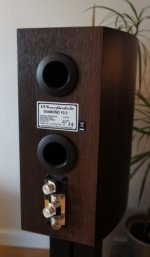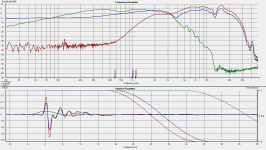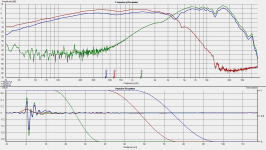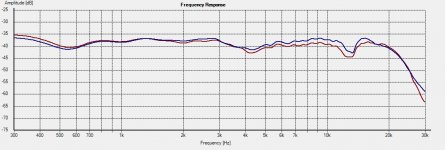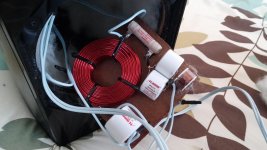Hi,
I've done a four part review and some DIY mod suggestions on the Wharfedale Diamond 10.2 loudspeaker for those who are interested!
Wharfedale Diamond 10.2 review part 1
Wharfedale Diamond 10.2 review part 2
Wharfedale Diamond 10.2 review part 3
Wharfedale Diamond 10.2 review part 4
Regards
/Göran
I've done a four part review and some DIY mod suggestions on the Wharfedale Diamond 10.2 loudspeaker for those who are interested!
Wharfedale Diamond 10.2 review part 1
Wharfedale Diamond 10.2 review part 2
Wharfedale Diamond 10.2 review part 3
Wharfedale Diamond 10.2 review part 4
Regards
/Göran
Attachments
Good stuff, Gornir. 😀
That's what I call a proper evaluation. What a terrible sample you ran into. Without having your expertise, I don't think the average user would have picked up the faults. 😕
I suppose it removes the mystique to show the filter, but that is always the most interesting thing for me. That second order original crossover is quite shallow, isn't it? Near LR2 I'd think. The Bowers and Wilkins B&W 685 looks similar, but only uses a single capacitor IIRC. B&W Group North America Service & Support - Service Manuals
I like your upgrades idea. That is very DIY and the sort of thing that people like to do here. You might find this post interesting on ZD5-type ladder networks: http://www.diyaudio.com/forums/multi-way/236806-could-kind-soul-please-break-down-horrid-xover-10.html#post3520563
To my surprise, I found a regular 4th order treble works much the same way as a 3rd order plus ladder delay network if you flip the polarity.
4 ohm bass seems to be a bit simpler than 8 ohm to implement. I've noticed that trend a lot in commercial speakers. But woven Kevlar is something we don't usually consider in DIY for some reason. The bass Le was low too. Maybe a shorting ring in there. The Qts of 0.6 on a reflex was another surprise.
I shall reread the whole thing again later in the week. 😎
That's what I call a proper evaluation. What a terrible sample you ran into. Without having your expertise, I don't think the average user would have picked up the faults. 😕
I suppose it removes the mystique to show the filter, but that is always the most interesting thing for me. That second order original crossover is quite shallow, isn't it? Near LR2 I'd think. The Bowers and Wilkins B&W 685 looks similar, but only uses a single capacitor IIRC. B&W Group North America Service & Support - Service Manuals
I like your upgrades idea. That is very DIY and the sort of thing that people like to do here. You might find this post interesting on ZD5-type ladder networks: http://www.diyaudio.com/forums/multi-way/236806-could-kind-soul-please-break-down-horrid-xover-10.html#post3520563
To my surprise, I found a regular 4th order treble works much the same way as a 3rd order plus ladder delay network if you flip the polarity.
4 ohm bass seems to be a bit simpler than 8 ohm to implement. I've noticed that trend a lot in commercial speakers. But woven Kevlar is something we don't usually consider in DIY for some reason. The bass Le was low too. Maybe a shorting ring in there. The Qts of 0.6 on a reflex was another surprise.
I shall reread the whole thing again later in the week. 😎
Gomir,
A very good thorough review, this what I called an Engineering Review.
The first thing that comes my mine is the quality control from Wharfedale leaves a lot to be desired.
A very good thorough review, this what I called an Engineering Review.
The first thing that comes my mine is the quality control from Wharfedale leaves a lot to be desired.
Hi,
FWIW your picture of the bassmid clearly shows the sealing gasket.
rgds, sreten.
Hi Sreten,
Yes, that's the sealing gasket I put on. Originally it was non existing!
Regards
/Göran
Gomir,
A very good thorough review, this what I called an Engineering Review.
The first thing that comes my mine is the quality control from Wharfedale leaves a lot to be desired.
Thank you!
I think I had exceptional bad luck with my pair and I hate to think this should be a common quality control issue from Wharfedale. On the other hand e.g. the faulty wired cross-over was really bad and shouldn't slipped through the quality control.
I was also surprised to see that there was a thin layer of dust covering the speakers underneath the plastic wrap-in.
However my local Hifi shop gave me new replacement drivers for the faulty ones without hassle.
Regards
/Göran
Back in 2008 I had a pair of Diamond 9.6 which were modified due to poor sound. The walls were 16mm and were made of some particle board, that looked and felt more like cardboard but MDF. The drivers had cast aluminium baskets and quite good build quality, the finish however had issues too, box damping was taken care by a single roll of polyester fill behind the woofer.
The biggest issue with them turned out to lie in the crossover section - poorly executed crossover with a 5db dip in the 3-7Khz region, electrolytic caps and iron cored coils ( well, one was 13mH so that I could understand but the other was 1.3mH ).
Mod was close to this one - walls were treated with bitumen pads, sheep woolffrom Visaton replaced the small polyester rolls, crossovers went to ClarityCap PX and air cored coils, the mid-tweeter section was reworked to clear the, what looked like an intentionally designed, dip in the power response. They improved but not considerably and nowhere near a similarly priced DIY project. Together with those speakers I bought the then flagship Panasonic 50" TV available here and they sounded pretty much the same as the TV`s inbuilt speakers but with more bass.
The biggest issue with them turned out to lie in the crossover section - poorly executed crossover with a 5db dip in the 3-7Khz region, electrolytic caps and iron cored coils ( well, one was 13mH so that I could understand but the other was 1.3mH ).
Mod was close to this one - walls were treated with bitumen pads, sheep woolffrom Visaton replaced the small polyester rolls, crossovers went to ClarityCap PX and air cored coils, the mid-tweeter section was reworked to clear the, what looked like an intentionally designed, dip in the power response. They improved but not considerably and nowhere near a similarly priced DIY project. Together with those speakers I bought the then flagship Panasonic 50" TV available here and they sounded pretty much the same as the TV`s inbuilt speakers but with more bass.
Hello Gornir,
I recently got a pair of used wfd 10.2 and stumbled upon the excellent article on your audioexcite website. I have been following your work since then. Great stuff!!
So i undertook upgrade of the 10.2 based on your work. I performed the full Level 1 surgery including air core inductors for the woofer XO.
Unfortunately i am quite unhappy with the end results. I'm in no way questioning your work on the wfd10.2. So please do not misunderstand me.
I am posting only to see if you could offer some comments on what directions i should consider for my investigation.
I understand there is no useful inputs that can be provided without access to measurement, listening and physical inspection.
I have attempted to overcome that by posting some quick and dirty measurements i made using HOLM impulse.
I see a big dip arounf the XO point and also see that the L and R speakers measure quite differently.
I have used the hiigh quality parts recommended in your article and the aircore inductor is a Solen unwound to 1.6MH (DCR of .29) (havent measured to confirm but this was done for me by madisound)
Please offer some comments.
thanks
Joji
I recently got a pair of used wfd 10.2 and stumbled upon the excellent article on your audioexcite website. I have been following your work since then. Great stuff!!
So i undertook upgrade of the 10.2 based on your work. I performed the full Level 1 surgery including air core inductors for the woofer XO.
Unfortunately i am quite unhappy with the end results. I'm in no way questioning your work on the wfd10.2. So please do not misunderstand me.
I am posting only to see if you could offer some comments on what directions i should consider for my investigation.
I understand there is no useful inputs that can be provided without access to measurement, listening and physical inspection.
I have attempted to overcome that by posting some quick and dirty measurements i made using HOLM impulse.
I see a big dip arounf the XO point and also see that the L and R speakers measure quite differently.
I have used the hiigh quality parts recommended in your article and the aircore inductor is a Solen unwound to 1.6MH (DCR of .29) (havent measured to confirm but this was done for me by madisound)
Please offer some comments.
thanks
Joji
Attachments
Hello Gornir,
I recently got a pair of used wfd 10.2 and stumbled upon the excellent article on your audioexcite website. I have been following your work since then. Great stuff!!
So i undertook upgrade of the 10.2 based on your work. I performed the full Level 1 surgery including air core inductors for the woofer XO.
Unfortunately i am quite unhappy with the end results. I'm in no way questioning your work on the wfd10.2. So please do not misunderstand me.
I am posting only to see if you could offer some comments on what directions i should consider for my investigation.
I understand there is no useful inputs that can be provided without access to measurement, listening and physical inspection.
I have attempted to overcome that by posting some quick and dirty measurements i made using HOLM impulse.
I see a big dip arounf the XO point and also see that the L and R speakers measure quite differently.
I have used the hiigh quality parts recommended in your article and the aircore inductor is a Solen unwound to 1.6MH (DCR of .29) (havent measured to confirm but this was done for me by madisound)
Please offer some comments.
thanks
Joji
Hi Joji,
I'm sorry to hear that you had issues with your Wharfedale 10.2 mod.
I have a few questions to you.
- Did you do any “quick and dirty” measurements on the original speaker/x-over?
- Did you check the component values on the original x-over. Are they the same as the ones I described in the article?
- Can you check to see if the driver models (mid-woofer and tweeter) are the same as mine?
- Can you describe in more detail what it is you are unhappy with sonically compared to the original x-over?
I had three issues with my pair of Wharfedales. One of the x-overs had faulty wiring, one tweeter had significantly lower level than the other and one of the mid-woofers had a mechanical noise. I changed the faulty drivers and re-wired the faulty x-over.
To be able to better analyze your issue, can you please re-check your x-over wiring and try to reverse the polarity of the tweeter that has a dip in the response, in order to see if it is wrongly marked plus and minus? (I wouldn’t be surprised if it was).
Can you please redo the “quick and dirty” measurements as follows?
- Suspend the loudspeaker so that the tweeter is half way from the floor to the ceiling e.g. 1.25m from floor if the ceiling height is 2.5m and free from side walls etc.
- Set the measurement mic at tweeter height on-axis and place it at about 2m distance from the tweeter.
- Measure the loudspeaker with the new x-over and both drivers connected.
- Measure the loudspeaker with the new x-over and only the mid-woofer connected.
- Measure the loudspeaker with the new x-over and only the mid-tweeter connected.
- Measure the loudspeaker with the new x-over and both drivers connected, but with the tweeter reversed in polarity.
- Set the gating to about 400Hz on all of the measurements above and do not move the mic or speaker or change the amp level between measurements. Take some screenshots of the result.
- Repeat point 2-7 for a 15deg off-axis measurement.
- Repeat point 1-8 for the second loudspeaker.
These measurements might not be perfectly looking if you don’t have a calibrated mic and measurement setup, but it would give me some more information to point you in the right direction.
Regards
/Göran
Hello Gornir,
I recently got a pair of used wfd 10.2 and stumbled upon the excellent article on your audioexcite website. I have been following your work since then. Great stuff!!
So i undertook upgrade of the 10.2 based on your work. I performed the full Level 1 surgery including air core inductors for the woofer XO.
Unfortunately i am quite unhappy with the end results. I'm in no way questioning your work on the wfd10.2. So please do not misunderstand me.
I am posting only to see if you could offer some comments on what directions i should consider for my investigation.
I understand there is no useful inputs that can be provided without access to measurement, listening and physical inspection.
I have attempted to overcome that by posting some quick and dirty measurements i made using HOLM impulse.
I see a big dip arounf the XO point and also see that the L and R speakers measure quite differently.
I have used the hiigh quality parts recommended in your article and the aircore inductor is a Solen unwound to 1.6MH (DCR of .29) (havent measured to confirm but this was done for me by madisound)
Please offer some comments.
thanks
Joji
Joji,
Could you also change the HolmImpulse scale so it looks like the attached picture of my Wharfedale 10.2 original x-over measurement?
As you can see, one of my tweeters had significantly less output and the original x-over also have a dip around 4kHz.
/Göran
Attachments
Thanks much for getting back Goran.
Here are some of the answers
<Did you do any “quick and dirty” measurements on the original speaker/x-over?>
Unfortunately i did not measure the original loudspeaker. I invested in the measurement setup only after completing the upgrade. I have just started off spending time to develop this exiting field as a hobby. I am a novice in this, though i'm an electronics engineer by training and profession.
<Did you check the component values on the original x-over. Are they the same as the ones I described in the article?>
I did confirm that the resistor and capacitor values were exactly as in your article. I dont yet have the instruments to measure the inductors so couldnt confirm on them. However the crossovers looked exactly the same as in your article.
<Can you check to see if the driver models (mid-woofer and tweeter) are the same as mine?>
They looked exactly as pictured in your article, but i will open up and confirm
<Can you describe in more detail what it is you are unhappy with sonically compared to the original x-over?>
The speakers has lost its clarity. It sounds muffled and muddy.
<To be able to better analyze your issue, can you please re-check your x-over wiring and try to reverse the polarity of the tweeter that has a dip in the response, in order to see if it is wrongly marked plus and minus? (I wouldn’t be surprised if it was).>
When i opened the cabinet i did confirm that the wiring issue you encountered in your set wasn't present on mine. But over this weekend i will open them up and confirm if i made any mistakes in the wiring. Will wait to reverse the tweeter polarity till i can get you better measurements for you to analyze.
<Can you please redo the “quick and dirty” measurements as follows?>
I had performed a more careful on-axis measurements exactly as you described. however the mic distance was about 1m. I will perform the remaining measurements your have suggested over the weekend and pass them along.
These measurements might not be perfectly looking if you don’t have a calibrated mic and measurement setup, but it would give me some more information to point you in the right direction.
My measurement setup in not high end, but reasonable. I am using a calibrated Dayton Emm6 mic, focusrite preamp/usb audio interface. Trying out Holmimpulse and arta.
Here are some of the answers
<Did you do any “quick and dirty” measurements on the original speaker/x-over?>
Unfortunately i did not measure the original loudspeaker. I invested in the measurement setup only after completing the upgrade. I have just started off spending time to develop this exiting field as a hobby. I am a novice in this, though i'm an electronics engineer by training and profession.
<Did you check the component values on the original x-over. Are they the same as the ones I described in the article?>
I did confirm that the resistor and capacitor values were exactly as in your article. I dont yet have the instruments to measure the inductors so couldnt confirm on them. However the crossovers looked exactly the same as in your article.
<Can you check to see if the driver models (mid-woofer and tweeter) are the same as mine?>
They looked exactly as pictured in your article, but i will open up and confirm
<Can you describe in more detail what it is you are unhappy with sonically compared to the original x-over?>
The speakers has lost its clarity. It sounds muffled and muddy.
<To be able to better analyze your issue, can you please re-check your x-over wiring and try to reverse the polarity of the tweeter that has a dip in the response, in order to see if it is wrongly marked plus and minus? (I wouldn’t be surprised if it was).>
When i opened the cabinet i did confirm that the wiring issue you encountered in your set wasn't present on mine. But over this weekend i will open them up and confirm if i made any mistakes in the wiring. Will wait to reverse the tweeter polarity till i can get you better measurements for you to analyze.
<Can you please redo the “quick and dirty” measurements as follows?>
I had performed a more careful on-axis measurements exactly as you described. however the mic distance was about 1m. I will perform the remaining measurements your have suggested over the weekend and pass them along.
These measurements might not be perfectly looking if you don’t have a calibrated mic and measurement setup, but it would give me some more information to point you in the right direction.
My measurement setup in not high end, but reasonable. I am using a calibrated Dayton Emm6 mic, focusrite preamp/usb audio interface. Trying out Holmimpulse and arta.
Hi Goran,
One thing i was completely stumped with was the amount of acoustic stuffing to use. I used sheep wool as you suggested. But it was rather hard to work with. I may have over stuffed the cabinets or stuffed them with unmatched amounts? Could this mess with the sound?
One thing i was completely stumped with was the amount of acoustic stuffing to use. I used sheep wool as you suggested. But it was rather hard to work with. I may have over stuffed the cabinets or stuffed them with unmatched amounts? Could this mess with the sound?
Here are the on axis measurements i was referring to.
Over this weekend i will try and do holmImplulse measurements as you suggested.
Meanwhile, please see if this provides any insight.
Also included is a picture of the modified XO
Over this weekend i will try and do holmImplulse measurements as you suggested.
Meanwhile, please see if this provides any insight.
Also included is a picture of the modified XO
Attachments
<Can you describe in more detail what it is you are unhappy with sonically compared to the original x-over?>
The speakers has lost its clarity. It sounds muffled and muddy.
They should definitely not sound muffled or lose its clarity when changing the x-over components to better ones compared to the cheap stuff used in the original x-over. Assuming they have the correct values and the filter function hasn’t changed, they should have more transparency and clarity.
Even though, don’t expect miracles with these very simple drivers and rather un-optimized original x-over. Mod level 2 has a better x-over.
Regards
/Göran
Hi Goran,
One thing i was completely stumped with was the amount of acoustic stuffing to use. I used sheep wool as you suggested. But it was rather hard to work with. I may have over stuffed the cabinets or stuffed them with unmatched amounts? Could this mess with the sound?
Yes, this could be one issue. Try to remove all stuffing and listen to the speaker. Do they sound less muffled? If so, gradually add stuffing until you are satisfied.
No stuffing should be in contact with the mid-woofer and the bass-reflex ports should not be obstructed by stuffing. Start to fill some stuffing in the back of the enclosure.
Regards
/Göran
Here are the on axis measurements i was referring to.
Over this weekend i will try and do holmImplulse measurements as you suggested.
Meanwhile, please see if this provides any insight.
Also included is a picture of the modified XO
Oboy, The resistor alone costs more than the tweeter! 😉
You bought some expensive x-over components. I think you could have stayed with standard MOX resistors and the standard Mundorf M-Cap in order to get a satisfying result.
These are not high-end drivers and very expensive components can't change that, but I think one or two steps above the cheap components in the original x-over makes a difference.
Regards
/Göran
They should definitely not sound muffled or lose its clarity when changing the x-over components to better ones compared to the cheap stuff used in the original x-over. Assuming they have the correct values and the filter function hasn’t changed, they should have more transparency and clarity.
Even though, don’t expect miracles with these very simple drivers and rather un-optimized original x-over. Mod level 2 has a better x-over.
Hi Goran,
I understand that the drivers were pretty low grade, so i didn't really have very high expectations. However something seems off as he quality has degraded instead of minor improvement that i was hoping for.
thanks
Joji
Oboy, The resistor alone costs more than the tweeter! 😉
You bought some expensive x-over components. I think you could have stayed with standard MOX resistors and the standard Mundorf M-Cap in order to get a satisfying result.
These are not high-end drivers and very expensive components can't change that, but I think one or two steps above the cheap components in the original x-over makes a difference.
Regards
/Göran
Hi
I picked up the lowest grade Mundorf parts available here with Madisound. I did sense that the drivers would be the limiting factor as you mentioned in your article. But i agree i could probably have settled for non Mundorf parts.
thanks
Joji
Yes, this could be one issue. Try to remove all stuffing and listen to the speaker. Do they sound less muffled? If so, gradually add stuffing until you are satisfied.
No stuffing should be in contact with the mid-woofer and the bass-reflex ports should not be obstructed by stuffing. Start to fill some stuffing in the back of the enclosure.
Regards
/Göran
Thanks. I will follow this direction to readjust the stuffing.
Any good way to match the amount of stuffing in L and R?
regards
Joji
Hi Goran,
Did you get a chance to look at the measurements in the pdf file?
Do you see something obviously wrong?
Something seems more off on the HF XO. Is it possible that the minor differences with respect to original parts of the resistance values of the high quality components affects their impedance value with frequency and hence the slope behavior of the XOs?
Also is it possible for the changes to have increased the distortions?
So here are somethings i will pursue based on your input
1. Make measurements
2. Rework the acoustic stuffing
3. Checking wiring polarity
4. check the quality of all contacts and solder
5. reverse tweeter polarity?
thanks
joji
Did you get a chance to look at the measurements in the pdf file?
Do you see something obviously wrong?
Something seems more off on the HF XO. Is it possible that the minor differences with respect to original parts of the resistance values of the high quality components affects their impedance value with frequency and hence the slope behavior of the XOs?
Also is it possible for the changes to have increased the distortions?
So here are somethings i will pursue based on your input
1. Make measurements
2. Rework the acoustic stuffing
3. Checking wiring polarity
4. check the quality of all contacts and solder
5. reverse tweeter polarity?
thanks
joji
- Home
- Loudspeakers
- Multi-Way
- Wharfedale Diamond 10.2 review and DIY mods
